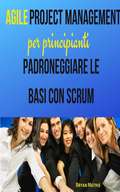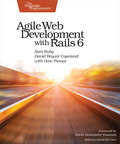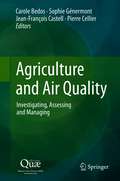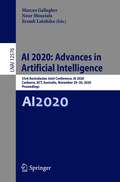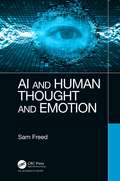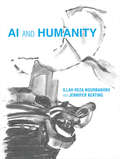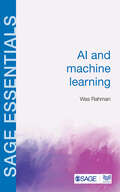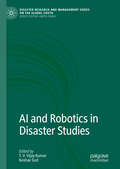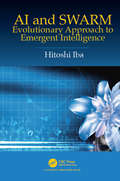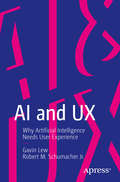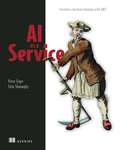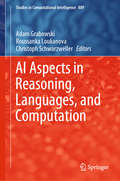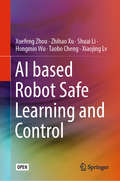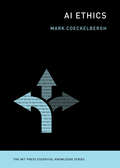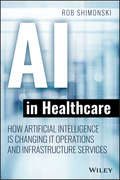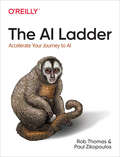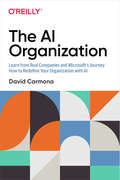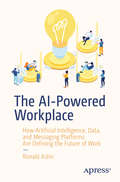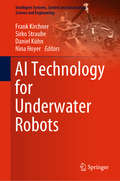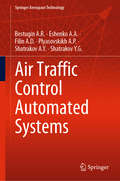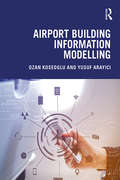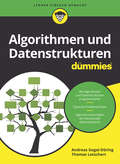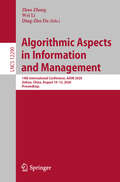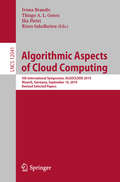- Table View
- List View
Agile Project Management per principianti: Padroneggiare le basi con Scrum
by Bryan MathisL'approccio Agile nella gestione dei progetti sta guadagnando popolarità perché ottiene risultati migliori in meno tempo con team più piccoli rispetto ai metodi vecchi, rigidi e plan-based. Nell'economia odierna basata sulle informazioni in cui Internet guida il mercato di nuovi prodotti e le esigenze dei clienti cambiano dall'oggi al domani, Agile aiuta le aziende a stare al passo con le richieste dei clienti accogliendo i rapidi cambiamenti come parte vitale del processo di sviluppo. Scritto per principianti, questo libro spiega i concetti di Agile usando l'approccio Scrum e li inserisce in un quadro coerente. Invece di limitarsi a una definizione di termini, presenta Agile come un sistema vivente e dinamico eliminare le perdite di tempo e tornando alle basi mentre si gestiscono i progetti. La prima metà del libro spiega dettagliatamente il Manifesto Agile, sia in teoria che in pratica. La seconda metà del libro fornisce spiegazioni dettagliate per l'applicazione di Scrum, che è un metodo Agile noto per la sua semplicità e facilità di implementazione. Le piccole start-up e gli imprenditori troveranno consigli pratici, incoraggiamento e ispirazione in questo libro, mentre i team di sviluppo delle aziende più grandi apprezzeranno la sua spiegazione chiara e concisa di come i pezzi del puzzle Agile si incastrano.
Agile Web Development with Rails 6
by Sam Ruby David B. Copeland Dave ThomasLearn Rails the way the Rails core team recommends it, along with the tens of thousands of developers who have used this broad, far-reaching tutorial and reference. If you're new to Rails, you'll get step-by-step guidance. If you're an experienced developer, get the comprehensive, insider information you need for the latest version of Ruby on Rails. The new edition of this award-winning classic is completely updated for Rails 6 and Ruby 2.6, with information on system testing, Webpack, and advanced JavaScript. Ruby on Rails helps you produce high-quality, beautiful-looking web applications quickly - you concentrate on creating the application, and Rails takes care of the details. Rails 6 brings many improvements, and this edition is updated to cover the new features and changes in best practices. We start with a step-by-step walkthrough of building a real application, and in-depth chapters look at the built-in Rails features. Follow along with an extended tutorial as you write a web-based store application. Eliminate tedious configuration and housekeeping, seamlessly incorporate Ajax and JavaScript, send and receive emails, manage background jobs with ActiveJob, and build real-time features using WebSockets and ActionCable. Test your applications as you write them using the built-in unit, integration, and system testing frameworks, internationalize your applications, and deploy your applications easily and securely. New in this edition is coverage of Action Mailer, which allows you to receive emails in your app as well as ActionText, a zero-configuration rich text editing feature. Rails 1.0 was released in December 2005. This book was there from the start, and didn't just evolve alongside Rails, it evolved with Rails. It has been developed in consultation with the Rails core team. In fact, Rails itself is tested against the code in this book. What You Need: All you need is a Windows, Mac OS X, or Linux machine to do development on. This book will take you through the steps to install Rails and its dependencies. If you aren't familiar with the Ruby programming language, this book contains a chapter that covers the basics necessary to understand the material in the book.
Agriculture and Air Quality: Investigating, Assessing and Managing
by Carole Bedos Sophie Génermont Jean-François Castell Pierre CellierThis book gives an overview of the relationships between agriculture and air quality, which is an issue of increasing importance for practitioners and policy makers. It provides the keys to understand natural and anthropogenic mechanisms governing emission and deposition of pollutants produced by and/or impacting agricultural activitiesIt identifies how management practices can help mitigating emissions and how public policies on air pollution progressively addressed the agricultural sectorThis book was written for students, researchers and agriculture actors as well as for public decision-makers
AI 2020: 33rd Australasian Joint Conference, AI 2020, Canberra, ACT, Australia, November 29–30, 2020, Proceedings (Lecture Notes in Computer Science #12576)
by Marcus Gallagher Nour Moustafa Erandi LakshikaThis book constitutes the proceedings of the 33rd Australasian Joint Conference on Artificial Intelligence, AI 2020, held in Canberra, ACT, Australia, in November 2020.*The 36 full papers presented in this volume were carefully reviewed and selected from 57 submissions. The paper were organized in topical sections named: applications; evolutionary computation; fairness and ethics; games and swarms; and machine learning. *The conference was held virtually due to the COVID-19 pandemic.
AI and Human Thought and Emotion
by Sam FreedThe field of artificial intelligence (AI) has grown dramatically in recent decades from niche expert systems to the current myriad of deep machine learning applications that include personal assistants, natural-language interfaces, and medical, financial, and traffic management systems. This boom in AI engineering masks the fact that all current AI systems are based on two fundamental ideas: mathematics (logic and statistics, from the 19th century), and a grossly simplified understanding of biology (mainly neurons, as understood in 1943). This book explores other fundamental ideas that have the potential to make AI more anthropomorphic. Most books on AI are technical and do not consider the humanities. Most books in the humanities treat technology in a similar manner. AI and Human Thought and Emotion, however is about AI, how academics, researchers, scientists, and practitioners came to think about AI the way they do, and how they can think about it afresh with a humanities-based perspective. The book walks a middle line to share insights between the humanities and technology. It starts with philosophy and the history of ideas and goes all the way to usable algorithms. Central to this work are the concepts of introspection, which is how consciousness is viewed, and consciousness, which is accessible to humans as they reflect on their own experience. The main argument of this book is that AI based on introspection and emotion can produce more human-like AI. To discover the connections among emotion, introspection, and AI, the book travels far from technology into the humanities and then returns with concrete examples of new algorithms. At times philosophical, historical, and technical, this exploration of human emotion and thinking poses questions and provides answers about the future of AI.
AI and Humanity (The\mit Press Ser.)
by Illah Reza Nourbakhsh Jennifer KeatingAn examination of the implications for society of rapidly advancing artificial intelligence systems, combining a humanities perspective with technical analysis; includes exercises and discussion questions.AI and Humanity provides an analytical framing and a common language for understanding the effects of technological advances in artificial intelligence on society. Coauthored by a computer scientist and a scholar of literature and cultural studies, it is unique in combining a humanities perspective with technical analysis, using the tools of literary explication to examine the societal impact of AI systems. It explores the historical development of these technologies, moving from the apparently benign Roomba to the considerably more sinister semi-autonomous weapon system Harpy. The book is driven by an exploration of the cultural and etymological roots of a series of keywords relevant to both AI and society. Works examined range from Narrative of the Life of Frederick Douglass, given a close reading for its themes of literacy and agency, to Simon Head's critique of the effects of surveillance and automation on the Amazon labor force in Mindless.Originally developed as a textbook for an interdisciplinary humanities-science course at Carnegie Mellon, AI & Humanity offers discussion questions, exercises (including journal writing and concept mapping), and reading lists. A companion website provides updated resources and a portal to a video archive of interviews with AI scientists, sociologists, literary theorists, and others.
AI and Machine Learning (SAGE Essentials)
by Was RahmanWas Rahman′s AI and Machine Learning achieves that rare balance of making a difficult and complex topic accessible to non-specialists, without dumbing down. He starts with an enlightening and entertaining explanation of what artificial intelligence (AI) is and how it works. This includes often-overlooked fundamentals like what we actually mean by ′intelligence′, artificial or otherwise. Rahman brings his explanations to life with lucid and, at times, surprising examples of AI already in use around us. He takes these back to first principles, deftly avoiding any need to understand the maths or computing involved. This allows him to demystify what the technology is really doing and show us that much of it is reassuringly mundane, despite the hype. This distinctive approach comes into its own when examining the challenges and risks of AI. It allows the author to remove the drama and fear of sensationalized headlines and doom-laden movie plots. In their place, he offers an insightful analysis of how the major issues surface, what options we have for addressing them and why some dilemmas may prove intractable. A must-read to understand the reality and implications of AI beyond the hype!
AI and Robotics in Disaster Studies (Disaster Research and Management Series on the Global South)
by T. V. Vijay Kumar Keshav SudThis book promotes a meaningful and appropriate dialogue and cross-disciplinary partnerships on Artificial Intelligence (AI) in governance and disaster management. The frequency and the cost of losses and damages due to disasters are rising every year. From wildfires to tsunamis, drought to hurricanes, floods to landslides combined with chemical, nuclear and biological disasters of epidemic proportions has increased human vulnerability and ecosystem sustainability. Life is not as it used to be and governance to manage disasters cannot be a business as usual. The quantum and proportion of responsibilities with the emergency services has increased many times to strain them beyond their human capacities. Its time that the struggling disaster management services get supported and facilitated by new technology of combining Artificial Intelligence (AI) and Machine Learning (ML) with Data Analytics Technologies (DAT)to serve people and government in disaster management. AI and ML have advanced to a state where they could be utilized for many operations in disaster risk reduction. Even though many disasters cannot be prevented and a number of them are blind natural disasters yet through an appropriate application of AI and ML quick predictions, vulnerability identification and classification of relief and rescue operations could be achieved.
AI and SWARM: Evolutionary Approach to Emergent Intelligence
by Hitoshi IbaThis book provides theoretical and practical knowledge on AI and swarm intelligence. It provides a methodology for EA (evolutionary algorithm)-based approach for complex adaptive systems with the integration of several meta-heuristics, e.g., ACO (Ant Colony Optimization), ABC (Artificial Bee Colony), and PSO (Particle Swarm Optimization), etc. These developments contribute towards better problem-solving methodologies in AI. The book also covers emerging uses of swarm intelligence in applications such as complex adaptive systems, reaction-diffusion computing, and diffusion-limited aggregation, etc. Another emphasis is its real-world applications. We give empirical examples from real-world problems and show that the proposed approaches are successful when addressing tasks from such areas as swarm robotics, silicon traffics, image understanding, Vornoi diagrams, queuing theory, and slime intelligence, etc. Each chapter begins with the background of the problem followed by the current state-of-the-art techniques of the field, and ends with a detailed discussion. In addition, the simulators, based on optimizers such as PSO and ABC complex adaptive system simulation, are described in detail. These simulators, as well as some source codes, are available online on the author’s website for the benefit of readers interested in getting some hands-on experience of the subject. The concepts presented in this book aim to promote and facilitate the effective research in swarm intelligence approaches in both theory and practice. This book would also be of value to other readers because it covers interdisciplinary research topics that encompass problem-solving tasks in AI, complex adaptive systems, and meta-heuristics.
AI and UX: Why Artificial Intelligence Needs User Experience
by Gavin Lew Robert M. Schumacher Jr.Shine a light on how user experience (UX) will play a significant role in adoption of AI technologies across industries. This book explores how AI must be developed within a UX framework. The authors start by asking the question “how do we make AI smarter?” You will then quickly realize that the tried and true techniques of AI have been all about getting smarter. While we are making massive inroads, these may not be making AI more successful. It is not just about getting a product to market; it is—as always—about getting the product into people’s hands in a form that will be used. That demands examining the product from the perspective of the user—a stage of product development we have come to accept as fundamental. But the new world of AI will necessitate a new “UX lens” for us to see through. We should be asking the questions that will get us to that new lens. This book is based on interviews on technologists in the field of AI and UX. It is comprised of three core areas: 1) The history of AI, 2) Product examples and failures, and 3) A UX framework to make AI successful. What You'll Learn Understand how the usage and success of AI depends on a great user experience Discover how technology can advance beyond “it works” to “it works well,” which subsequently increases its adoptionDetermine what ways can we let the users enhance the data to make AI better attuned to their needsRealize how you can make humans smarter in their interactions with AI Who This Book Is For Those interested in AI and future implications; these can be futurists, technophiles, or product designers and product managers working on AI products
AI as a Service: Serverless machine learning with AWS
by Peter Elger Eóin ShanaghyAI as a Service is a practical handbook to building and implementing serverless AI applications, without bogging you down with a lot of theory. Instead, you&’ll find easy-to-digest instruction and two complete hands-on serverless AI builds in this must-have guide!Summary Companies everywhere are moving everyday business processes over to the cloud, and AI is increasingly being given the reins in these tasks. As this massive digital transformation continues, the combination of serverless computing and AI promises to become the de facto standard for business-to-consumer platform development—and developers who can design, develop, implement, and maintain these systems will be in high demand! AI as a Service is a practical handbook to building and implementing serverless AI applications, without bogging you down with a lot of theory. Instead, you&’ll find easy-to-digest instruction and two complete hands-on serverless AI builds in this must-have guide! Purchase of the print book includes a free eBook in PDF, Kindle, and ePub formats from Manning Publications. About the technology Cloud-based AI services can automate a variety of labor intensive business tasks in areas such as customer service, data analysis, and financial reporting. The secret is taking advantage of pre-built tools like Amazon Rekognition for image analysis or AWS Comprehend for natural language processing. That way, there&’s no need to build expensive custom software. Artificial Intelligence (AI), a machine&’s ability to learn and make predictions based on patterns it identifies, is already being leveraged by businesses around the world in areas like targeted product recommendations, financial forecasting and resource planning, customer service chatbots, healthcare diagnostics, data security, and more. With the exciting combination of serverless computing and AI, software developers now have enormous power to improve their businesses&’ existing systems and rapidly deploy new AI-enabled platforms. And to get on this fast-moving train, you don&’t have to invest loads of time and effort in becoming a data scientist or AI expert, thanks to cloud platforms and the readily available off-the-shelf cloud-based AI services! About the book AI as a Service is a fast-paced guide to harnessing the power of cloud-based solutions. You&’ll learn to build real-world apps—such as chatbots and text-to-speech services—by stitching together cloud components. Work your way from small projects to large data-intensive applications. What's inside - Apply cloud AI services to existing platforms - Design and build scalable data pipelines - Debug and troubleshoot AI services - Start fast with serverless templates About the reader For software developers familiar with cloud basics. About the author Peter Elger and Eóin Shanaghy are founders and CEO/CTO of fourTheorem, a software solutions company providing expertise on architecture, DevOps, and machine learning. Table of Contents PART 1 - FIRST STEPS 1 A tale of two technologies 2 Building a serverless image recognition system, part 1 3 Building a serverless image recognition system, part 2 PART 2 - TOOLS OF THE TRADE 4 Building and securing a web application the serverless way 5 Adding AI interfaces to a web application 6 How to be effective with AI as a Service 7 Applying AI to existing platforms PART 3 - BRINGING IT ALL TOGETHER 8 Gathering data at scale for real-world AI 9 Extracting value from large data sets with AI
AI Aspects in Reasoning, Languages, and Computation (Studies in Computational Intelligence #889)
by Roussanka Loukanova Adam Grabowski Christoph SchwarzwellerThis book builds on decades of research and provides contemporary theoretical foundations for practical applications to intelligent technologies and advances in artificial intelligence (AI). Reflecting the growing realization that computational models of human reasoning and interactions can be improved by integrating heterogeneous information resources and AI techniques, its ultimate goal is to promote integrated computational approaches to intelligent computerized systems. The book covers a range of interrelated topics, in particular, computational reasoning, language, syntax, semantics, memory, and context information. The respective chapters use and develop logically oriented methods and techniques, and the topics selected are from those areas of logic that contribute to AI and provide its mathematical foundations.The intended readership includes researchers working in the areas of traditional logical foundations, and on new approaches to intelligent computational systems.
AI based Robot Safe Learning and Control
by Xuefeng Zhou Zhihao Xu Shuai Li Hongmin Wu Taobo Cheng Xiaojing LvThis open access book mainly focuses on the safe control of robot manipulators. The control schemes are mainly developed based on dynamic neural network, which is an important theoretical branch of deep reinforcement learning. In order to enhance the safety performance of robot systems, the control strategies include adaptive tracking control for robots with model uncertainties, compliance control in uncertain environments, obstacle avoidance in dynamic workspace. The idea for this book on solving safe control of robot arms was conceived during the industrial applications and the research discussion in the laboratory. Most of the materials in this book are derived from the authors’ papers published in journals, such as IEEE Transactions on Industrial Electronics, neurocomputing, etc. This book can be used as a reference book for researcher and designer of the robotic systems and AI based controllers, and can also be used as a reference book for senior undergraduate and graduate students in colleges and universities.
AI Ethics (The MIT Press Essential Knowledge series)
by Mark CoeckelberghAn accessible synthesis of ethical issues raised by artificial intelligence that moves beyond hype and nightmare scenarios to address concrete questions.Artificial intelligence powers Google's search engine, enables Facebook to target advertising, and allows Alexa and Siri to do their jobs. AI is also behind self-driving cars, predictive policing, and autonomous weapons that can kill without human intervention. These and other AI applications raise complex ethical issues that are the subject of ongoing debate. This volume in the MIT Press Essential Knowledge series offers an accessible synthesis of these issues. Written by a philosopher of technology, AI Ethics goes beyond the usual hype and nightmare scenarios to address concrete questions.Mark Coeckelbergh describes influential AI narratives, ranging from Frankenstein's monster to transhumanism and the technological singularity. He surveys relevant philosophical discussions: questions about the fundamental differences between humans and machines and debates over the moral status of AI. He explains the technology of AI, describing different approaches and focusing on machine learning and data science. He offers an overview of important ethical issues, including privacy concerns, responsibility and the delegation of decision making, transparency, and bias as it arises at all stages of data science processes. He also considers the future of work in an AI economy. Finally, he analyzes a range of policy proposals and discusses challenges for policymakers. He argues for ethical practices that embed values in design, translate democratic values into practices and include a vision of the good life and the good society.
AI in Healthcare: How Artificial Intelligence Is Changing IT Operations and Infrastructure Services
by Robert ShimonskiThe best source for cutting-edge insights into AI in healthcare operations AI in Healthcare: How Artificial Intelligence Is Changing IT Operations and Infrastructure Services collects, organizes and provides the latest, most up-to-date research on the emerging technology of artificial intelligence as it is applied to healthcare operations. Written by a world-leading technology executive specializing in healthcare IT, this book provides concrete examples and practical advice on how to deploy artificial intelligence solutions in your healthcare environment. AI in Healthcare reveals to readers how they can take advantage of connecting real-time event correlation and response automation to minimize IT disruptions in critical healthcare IT functions. This book provides in-depth coverage of all the most important and central topics in the healthcare applications of artificial intelligence, including: Healthcare IT AI Clinical Operations AI Operational Infrastructure Project Planning Metrics, Reporting, and Service Performance AIOps in Automation AIOps Cloud Operations Future of AI Written in an accessible and straightforward style, this book will be invaluable to IT managers, administrators, and engineers in healthcare settings, as well as anyone with an interest or stake in healthcare technology.
The AI Ladder: Accelerate Your Journey to AI
by Rob Thomas Paul ZikopoulosAI may be the greatest opportunity of our time, with the potential to add nearly $16 trillion to the global economy over the next decade. But so far, adoption has been much slower than anticipated, or so headlines may lead you to believe. With this practical guide, business leaders will discover where they are in their AI journey and learn the steps necessary to successfully scale AI throughout their organization.Authors Rob Thomas and Paul Zikopoulos from IBM introduce C-suite executives and business professionals to the AI Ladder—a unified, prescriptive approach to help them understand and accelerate the AI journey. <P><P>Complete with real-world examples and real-life experiences, this book explores AI drivers, value, and opportunity, as well as the adoption challenges organizations face. Understand why you can’t have AI without an information architecture (IA) <P><P>Appreciate how AI is as much a cultural change as it is a technological one <P><P>Collect data and make it simple and accessible, regardless of where it lives <P><P>Organize data to create a business-ready analytics foundation <P><P>Analyze data, and build and scale AI with trust and transparency <P><P>Infuse AI throughout your entire business and create intelligent workflows
The AI Organization: Learn from Real Companies and Microsoft’s Journey How to Redefine Your Organization with AI
by David CarmonaMuch in the same way that software transformed business in the past two decades, AI is set to redefine organizations and entire industries. Just as every company is a software company today, every company will soon be an AI company.This practical guide explains how business and technical leaders can embrace this new breed of organization. Based on real customer experience, Microsoft’s David Carmona covers the journey necessary to become an AI Organization—from applying AI in your business today to the deep transformation that can empower your organization to redefine the industry.You'll learn the core concepts of AI as they are applied to real business, explore and prioritize the most appropriate use cases for AI in your company, and drive the organizational and cultural change needed to transform your business with AI.
The AI-Powered Workplace: How Artificial Intelligence, Data, and Messaging Platforms Are Defining the Future of Work
by Ronald AshriWe are entering the next wave of digital transformation. Artificial intelligence has an ever-increasing significance in our daily lives, and there is no difference when it comes to our workplaces. It is up to you to choose how to utilize these new tools to sharpen your organization’s competitive advantage, improve your team’s well-being, and help your business thrive. In The AI-Powered Workplace, author Ronald Ashri provides a map of the digital landscape to guide you on this timely journey. You’ll understand how the combination of AI, data, and conversational collaboration platforms—such as Slack, Microsoft Teams, and Facebook Workplace—is leading us to a radical shift in how we communicate and solve problems in the modern workplace. Our ability to automate decision-making processes through the application of AI techniques and through modern collaboration tools is a game-changer. Ashri skillfully presents his industry expertise and captivating insights so you have a thorough understanding of how to best combine these technologies with execution strategies that are optimized to your specific needs. The AI-Powered Workplace is an essential technical, cultural, and business handbook that arms you with clear steps to redefine and improve how you get work done. Software is now a proactive workplace partner revolutionizing all aspects of our professional lives from how we collaborate in the digital sphere to the literal physical environments in which we operate our business. This book not only ensures that you do not get left behind, but that you are consistently light years ahead of the pack.What You'll LearnLearn how the introduction of AI-powered applications in the workplace replaces or augments our capabilities and enables activities that were not possible beforeRealize how the combination of AI, data, and messaging platforms (Slack, Microsoft Teams, Skype, WhatsApp) leads to a radical shift in how we communicate, collaborate, and solve problemsDevelop strategies for the digital transformation of organizations through the use of AI-powered applications (from simple chatbots to more complex conversational applications) that operate within messaging environments we use to collaborate with our colleagues dailyKnow the dangers and ethical questions that the introduction of these technologies can cause in the workplace Who This Book is ForProfessionals at all levels interested in learning how AI, conversational platforms, and data can change organizations, including but not limited to team leaders, managers, and CxOs
AI Technology for Underwater Robots (Intelligent Systems, Control and Automation: Science and Engineering #96)
by Frank Kirchner Sirko Straube Daniel Kühn Nina HoyerThis book provides exclusive insight into the development of a new generation of robotic underwater technologies. Deploying and using even the most simple and robust mechanical tools is presenting a challenge, and is often associated with an enormous amount of preparation, continuous monitoring, and maintenance. Therefore, all disciplinary aspects (e.g. system design, communication, machine learning, mapping and coordination, adaptive mission planning) are examined in detail and together this gives an extensive overview on research areas influencing next generation underwater robots. These robotic underwater systems will operate autonomously with the help of the most modern artificial intelligence procedures and perform environmental monitoring as well as inspection and maintenance of underwater structures. The systems are designed as modular and reconfigurable systems for long term autonomy to remain at the site for longer periods of time. New communication methods using AI enable missions of hybrid teams of humans and heterogeneous robots. Thus this volume will be an important reference for scientists on every qualification level in the field of underwater technologies, industrial maritime applications, and maritime science.
Air Traffic Control Automated Systems (Springer Aerospace Technology)
by Bestugin A.R. Eshenko A.A. Filin A.D. Plyasovskikh A.P. Shatrakov A.Y. Shatrakov Y.G.This book highlights operation principles for Air Traffic Control Automated Systems (ATCAS), new scientific directions in design and application of dispatching training simulators and parameters of ATCAS radio equipment items for aircraft positioning. This book is designed for specialists in air traffic control and navigation at a professional and scientific level. The following topics are also included in this book: personnel actions in emergency, including such unforeseen circumstances as communication failure, airplane wandering off course, unrecognized aircraft appearance in the air traffic service zone, aerial target interception, fuel draining, airborne collision avoidance system (ACAS) alarm, emergency stacking and volcanic ash cloud straight ahead.
Airport Building Information Modelling
by Ozan Koseoglu Yusuf ArayiciThis book details how Building Information Modelling is being successfully deployed in the planning, design, construction and future operation of the Istanbul New Airport, a mega-scale construction project incorporating a varying mix of infrastructures including terminals, runways, passenger gates, car parks, railways and roads. The book demonstrates how Airport Building Information Modelling (ABIM) is being used to: • facilitate collaboration, cooperation and integrated project delivery • manage subcontractors and eliminate cost over-runs • reduce waste on site and enhance overall quality • connect people in a virtual environment to encourage collaborative working • provide clients with an effective interface for lifecycle management including: design development, construction documentation, construction phases and BIM and Big Data Integration for future facilities management The book presents a best practice BIM project, demonstrating concurrent engineering, lean processes, collaborative design and construction, and effective construction management. Moreover, the book provides a visionary exemplar for the further use of BIM technologies in civil engineering projects including highways, railways and others on the way towards the Smart City vision. It is essential reading for all Built Environment and Engineering stakeholders.
Alexandra and the Awful, Awkward, No Fun, Truly Bad Dates: A Picture Book Parody For Adults
by Rebekah ManleyFollow Alexandra and her adorable French bulldog pup Lottie as Alex goes on 30 dates in 30 days in this charming parody/comedic dating horror story all about dating apps, being stood up, and the other joys of millennial dating culture. Set in the thick of our swipe right society, newly thirty-year-old Alexandra decides she’s got nothing to lose and sets off on a 30-dates-in-30-days adventure. With her trusty French bulldog pup Lottie, Alex experiences the worst of millennial dating culture. From know-it-alls and bores to Mama’s boys and no-shows and everything else in between, you’ll be laughing along with Alex as she searches for love but ultimately discovers something a lot more meaningful. Alexandra and the Awful, Awkward, No Fun, Truly Bad Dates is the perfect gift for anyone who has swiped right, blind dated, or simply been a little bit lost in love at one point in their life.
Algorithmen und Datenstrukturen für Dummies (Für Dummies)
by Andreas Gogol-Döring Thomas LetschertDieses Buch führt Sie sachte in die Denkweisen des Fachs "Algorithmen und Datenstrukturen" ein. Es erklärt Informatik-Anfängern Terminologie, Notation und zentrale Inhalte des Fachgebiets auf anschauliche und sehr unterhaltsame Weise. Ein Fokus sind die Techniken und Tricks, die Sie brauchen, um effiziente Algorithmen und Datenstrukturen zu bauen. Sie werden auch in die Lage versetzt, Pseudocode in der typischen akademischen Darstellung zu verstehen und in unterschiedlichen Programmiersprachen zu realisieren oder umgekehrt grundlegende algorithmische Ideen als Pseudocode zu dokumentieren.
Algorithmic Aspects in Information and Management: 14th International Conference, AAIM 2020, Jinhua, China, August 10–12, 2020, Proceedings (Lecture Notes in Computer Science #12290)
by Zhao Zhang Wei Li Ding-Zhu DuThis volume constitutes the proceedings of the 14th International Conference on Algorithmic Aspects in Information and Management, AAIM 2020, held in Jinhua, China in August 2020. The 39 full papers and 17 short papers presented were carefully reviewed and selected from 76 submissions. The papers deal with emerging important algorithmic problems with a focus on the fundamental background, theoretical technology development, and real-world applications associated with information and management analysis, modeling and data mining. Special considerations are given to algorithmic research that was motivated by real-world applications.
Algorithmic Aspects of Cloud Computing: 5th International Symposium, ALGOCLOUD 2019, Munich, Germany, September 10, 2019, Revised Selected Papers (Lecture Notes in Computer Science #12041)
by Ivona Brandic Thiago A. L. Genez Ilia Pietri Rizos SakellariouThis book constitutes the refereed post-conference proceedings of the 5th International Symposium on Algorithmic Aspects of Cloud Computing, ALGOCLOUD 2019, held in Munich, Germany, in September 2019. The 8 revised full papers were carefully reviewed and selected from 16 submissions. The aim of the symposium is to present research activities and results on topics related to algorithmic, design, and development aspects of modern cloud-based systems.
